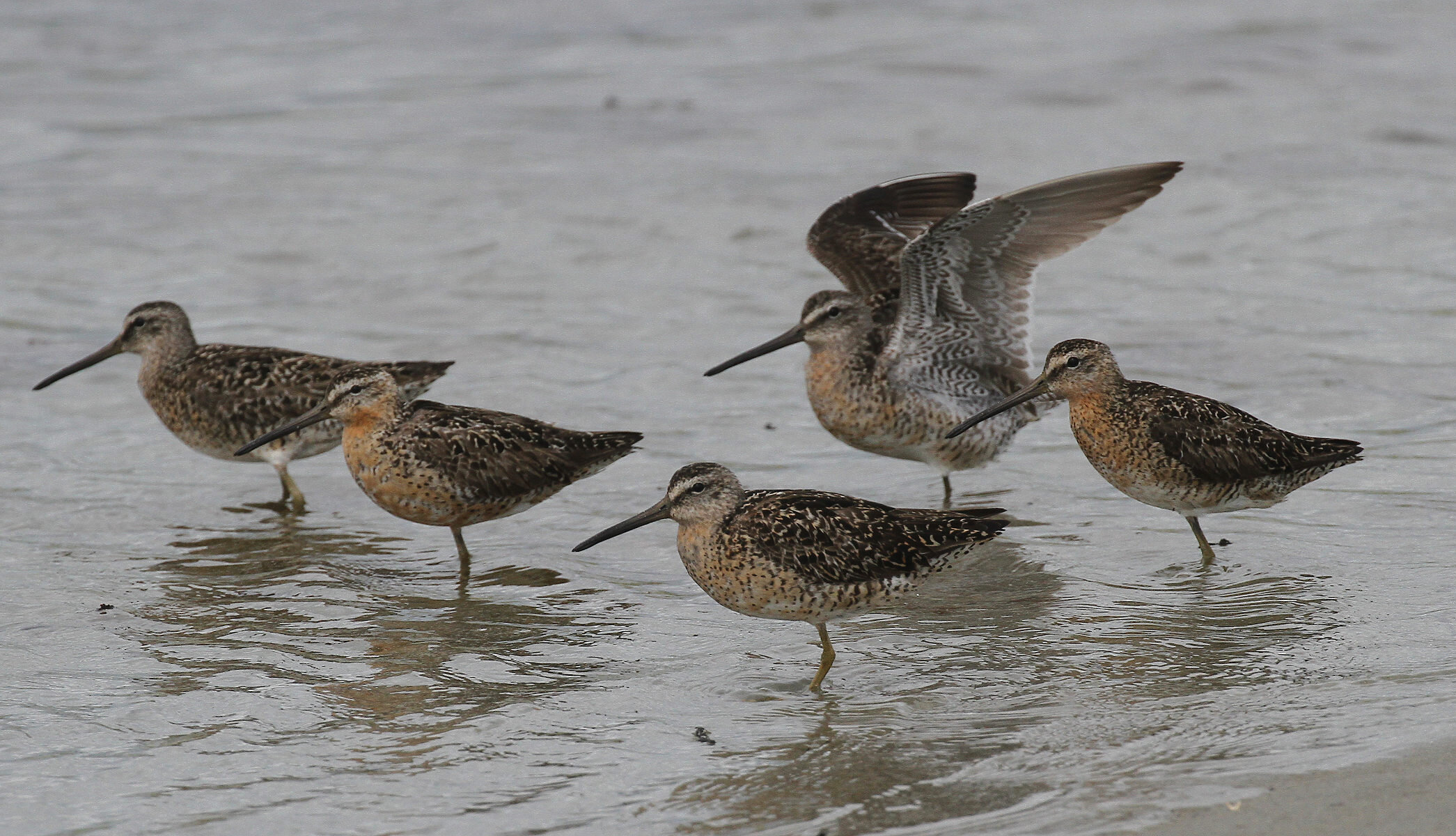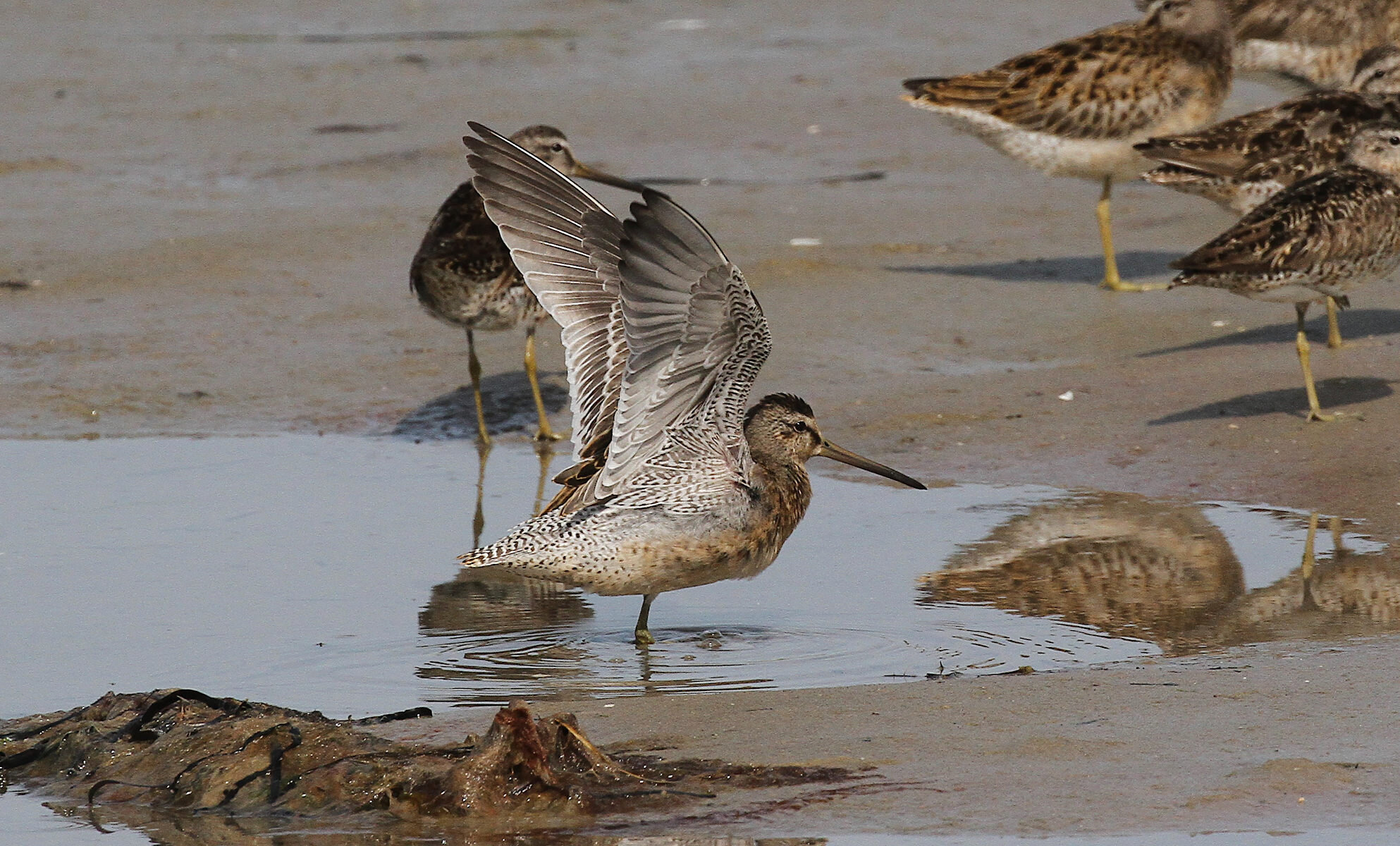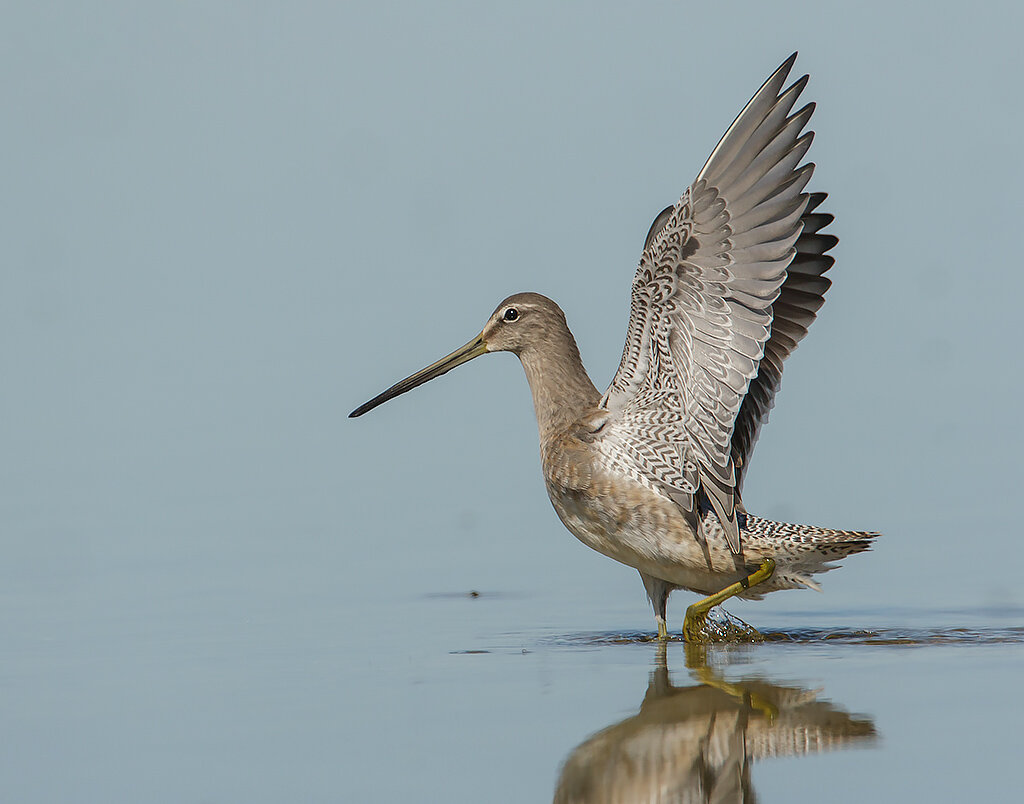Underwing pattern in dowitchers
Dowitchers have received significant attention in the literature, with perhaps a dozen papers published over the years describing new id features, including differences in structure and moult timing of the two species. Some of the published id features include: barring/spotting on the flanks, tail pattern, primary projection, overall coloration, spotting on the throat, width of terminal white band of the secondaries, and bill and head shape. All these features are highly variable, however, and none can be readily considered as fully diagnostic (except for the pattern of the tertials in juvenile plumage). Despite all this effort, a high proportion of the dowitchers seen in winter plumage are left unidentified, or identification is assumed to be the default species based on location and time-of-year.
In recent years, another feature has often been mentioned in online debates dealing with tricky dowitchers: the white underwing patch of Long-billed Dowitcher. This character is truly distinctive and much more diagnostic than any of the aforementioned features – it’s thus surprising that, to the best of my knowledge, no publication has described it in detail and discussed its variability. Its description as a ‘white patch’ is actually an oversimplification of a more general difference in plumage between the two species: the underwing barring. Let’s get deeper into dowitchers’ underwing patterns!
Short-billed Dowitchers, adults. Massachusetts, August 2017.
Pattern of underwing coverts
Both Short-billed and Long-billed Dowitchers share a very similar barring/patterning on the underwing; axillary feathers present a horizontal dark barring (normal to the shaft), and all the wing coverts show a dark ‘V‘/‘U’ (depending a bit on the particular feather) in the inner part of the feather but roughly parallel to the edge. Lesser coverts show purely white background, whereas both median and greater coverts show a greyish background and a much thicker V, and often some darkish vermiculations are present within the inner area of the ‘V’.
The main difference between the two species is the width of the dark bands, which is broader in Short-billed than in Long-billed, leading to a much more dense barring in the former. The difference is particularly obvious at the base of the wing. Many lesser coverts close to the body in Long-billed lack any dark patterning or if existing, the patterning is small and restricted to the feather base, so that at a distance it looks like a ‘white patch’. This patterning is more regular in all coverts in Short-billed, and thus the underwing looks more uniform grey.
These differences are clearly shown in Plate 1, but in the next paragraphs we will explore the variability of the underwing pattern and analyze the use of this feature in the field. Since Short-billed displays a limited variability in underwing pattern, we will study this species first, and then describe the overlap with the more variable Long-billed.
Plate 1. Underwing pattern in Long-billed (left) and Short-billed Dowitcher (right). Illustrations: Marti Franch / Subalpine Birding.
Short-billed Dowitcher
In this species the barring is dense, with dark and white bars of similar width in the axillaries, and broad dark ‘V’s quite uniform in all lesser coverts. Only the feathers at the wing base, exactly where the ‘white patch’ of Long-billed is, may present a broader white fringe, giving the area a bit paler appearance than the rest of the wing, which may lead to a false impression of a pale patch, especially with strong lights. However, I’ve been unable to find a single Short-billed Dowitcher (out of many hundreds) that truly lacks any dark patterning at the wing base, definitely making it a diagnostic feature. Beware, however, of blurry pictures in strong light that may cause confusion!
Short-billed comprises three subspecies with isolated populations (griseus, hendersoni and caurinus) that show distinct plumages in summer. In my experience, the underwing pattern is pretty similar in all the subspecies, with the dark barring being slightly broader and more boldly marked in griseus but differences are subtle.
Short-billed Dowitcher, adult, ssp griseus/hendersoni. Massachusetts, August 2017.
Short-billed Dowitcher, adults, ssp griseus. Massachusetts, August 2017. Note how the broad fringes of the lesser coverts close to the body form a hint of pale patch; however, as all the feathers do have visible dark patterning, the pale area looks dirtier and not as neat and white as in Long-billed. The broad barring on axillary feathers is also shown by most birds.
Short-billed Dowitcher, adult, ssp griseus. Massachusetts, August 2017. Another bird showing a slightly pale area at the wing base, due to the V marks restricted to the inner part of the feather on the lesser coverts close to the body.
Short-billed Dowitcher, adult, ssp caurinus. California, September 2017. A classic caurinus showing slightly finer barring on the axillary than the griseus shown above.
Short-billed Dowitcher, adults, ssp caurinus. California, September 2017. Uniform barring in all wing coverts typical of the species.
There exists, however, an obvious age-related variability in underwing pattern. Juvenile Short-billed Dowitchers show a much narrower barring than adults, both in the underwing and tail, such that they can look surprisingly pale overall when seen in flight, sometimes resembling Long-billed. The different pattern compared to adults is particularly obvious in the axillary feathers; in juveniles, the dark bars are often broken and show an irregular pattern, and are noticeably narrower than the white bars. In addition, the axillary feathers often show a fine line all along the feather contour, forming a characteristic pattern that is rarely shown by Long-billed.
Short-billed Dowitcher, juvenile (presumed ssp. griseus). Massachusetts, August 2017. Note the characteristic axillary pattern of juvenile, with irregular barring and a dark line along the feather contour forming a big V.
Short-billed Dowitcher, juvenile (left) and adult (right), ssp. griseus. Massachusetts, August 2017.
Short-billed Dowitcher, juvenile. Massachusetts, September 2017. Juvenile Short-billed Dowitchers often show quite pale tails.
Take-aways on Short-billed Dowitcher’s underwing:
uniformly barred underwing, with at most a slightly paler white patch at the wing base;
axillary feathers with an even barring, with dark bars at least 80% of the width of pale bars; and
much finer barring in juvenile birds, with a distinctive pattern in axillary feathers.
Long-billed Dowitcher
The ‘white patch’ described above is present in a high proportion of birds (well over 95%), and so there may be very little overlap with Short-billed. The underwing barring (density & width of dark bars) presents nevertheless a wider range of variability, leading to some overlap with Short-billed.
The palest birds show a very narrow barring, with dark bars of the axillary feathers being no more than 1/3 of the white bars; in such birds, the lack of dark markings extends from the wing base towards the carpal area, often forming a neat white band along the patagium, close to the leading edge of the wing. At the other end of the spectrum, some birds show a regular, broad barring in the axillary and lesser coverts, with dark bars of nearly the same width as white bars. These darker birds approach average Short-billed, but the white patch at the base looks well-contrasted and pretty obvious.
Juvenile Long-billed Dowitcher, California, October. Picture by Bob Steele. An average bird in terms of barring, note absence or just tiny ‘V’ marks on the lesser coverts close to the body and the leading edge of the wing.
Long-billed Dowitcher, adults, Alberta, Canada, May 2015. Picture by Brian Elder. At some distance, the underwing looks more uniform grey, but the white patch at the wing base is still obvious.
Long-billed Dowitcher, California, USA, February 2020. Picture by Steve Hampton. In winter, since the underparts are paler, the patch looks less contrasted but still obvious.
Long-billed Dowitcher, California, USA, November 2018. Picture by Brooke A Miller.
In a few birds the feathers that form the white patch do show some dark patterning (and thus there might be some overlap with Short-billed). However, even in these birds the white fringes are quite broad, and the dark mark is more like small spot/streak restricted to the inner part of the feather rather than a large, well-defined V as in most Short-billed Dowitchers. Beware of birds having a bath or preening, in which it can be difficult to assess the real pattern of these feathers if they are disordered and light effects could add confusion.
Long-billed Dowitcher, adult, New Brunswick, Canada. September 2019. Picture by Jim Carroll. Although not the darkest-winged Long-billed, note that this bird shows visible dark spots on the lesser coverts that usually form the white patch. The pattern still looks quite different from that typical of Short-billed. Surely there are trickier birds than this one out there, but they might be pretty rare!
In contrast to Short-billed, my impression is that juvenile Long-billed Dowitchers presents on average a darker underwing than adults, but there is much more overlap than in Short-billed. Therefore, the variability is mostly interindividual rather than age-related. Axillary feathers are barred as in adults (lacking the ‘contour line’ typically shown by juvenile Short-billed).
Takeaways on Long-billed Dowitcher’s underwing:
nearly all birds show a white patch at the wing base; and
in the axillary feathers, dark bars are always narrower than white bars, typically much so (note that this feature has been described before for tail feathers, but that isn’t reliable at all).














